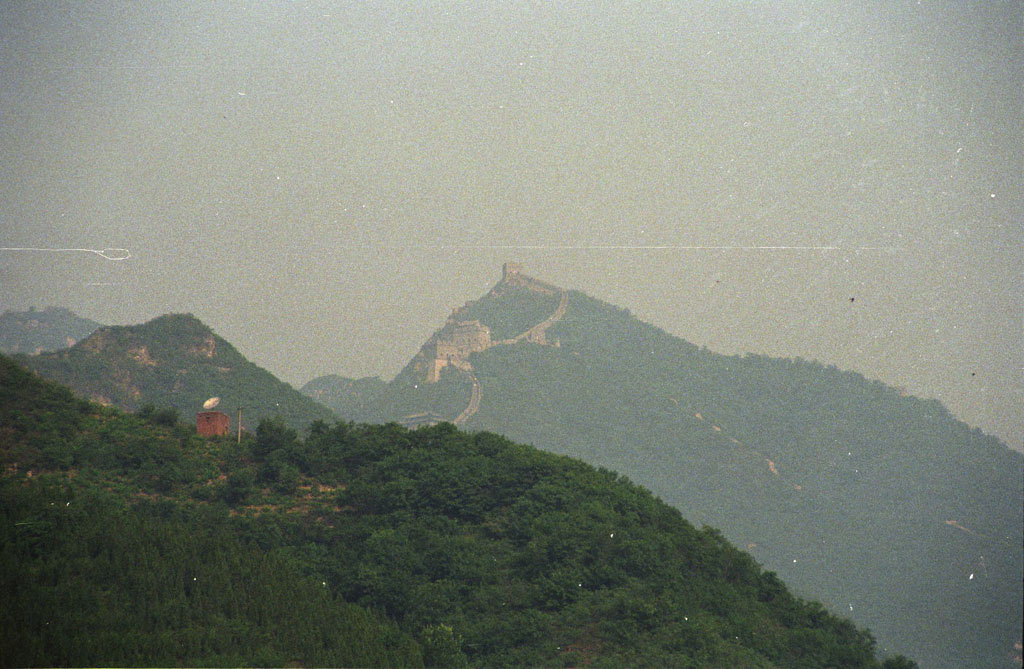
The
Great Walk to the Great Wall
I-Great Walk
There are but few persons in the world who have not dreamed about walking
along the Great Wall of China. Just imagine the feeling of walking there! But on this
trip, we did one betterwe had a Great
Walk TO the Great Wall! Yes, you read it right. We walked not just on the Wall,
but to it as well. Okay, so we didn't walk all the way to the Wall, but
the exact distance doesn't matter. Walking to the Wall is the important thing.
This set of pictures shows the Great Walk and how it came about.
The story began with a crazy idea of mine to combine a trip
to the Wall with a drive about the same distance beyond it (NW), to the cities
of Xuanhua and Zhangjiakou. This would take us into a different climatic regime,
one of aridity approaching that of the Gobi Desert, which lies just a little farther
in the same direction. By doing so, I would provide a valuable experience for
geologist Kelly and at the same time allow us both to see the kind of source
region that produces the Chinese desert dust that I have studied professionally
for 25 years. It is not widely realized that the mountains just NW of Beijing,
atop which the Great Wall stands, form a major climatic barrier that separates
Beijing and the humid coastal plain from the great desert areas of Inner
Mongolia and Mongolia proper. I wanted to take advantage of this strong climatic
gradient by driving it both ways in the one day that we had available.
Guoshun rented a Beijing taxi for the whole day, and in the
proper spirit of adventure we left Beijing Normal University early one Saturday
morning. There were five of us squeezed into a taxi that was not meant for such
a crew: Guoshun and Jinghua with their modest backpacks, Kelly with her big
one, me with my camera, and the driver. Jinghua and Kelly had brought some
rations for the long day.
The day was beautiful: clear and cool (both in the relative
sense, of course, for it was still Beijing in June). We made it out of the city
in fine style, and onto the new Badaling Expressway (designed to get busy
tourists in the New China to the Wall with a minimum of fuss and bother). This
is where our pictures begin.

I always wondered what my first view of the Great Wall would be like. Here is a typical first view of the Wall, as seen from the new highway. It shows a couple features of the Wall that are not always evident from picture books: (1) that it is on top of mountains, and (2) that it is often very steep. In fact, the Wall sits a top the highest mountains in this range. Placing it there increased its strategic value. Where the mountains are steep, so is the Wall. Also notice the defensive fortifications placed at intervals along the wall. But back to our story.

Everything went fine for the first hour or so of our trip. We had left
Beijing and were approaching the mountains. Just after we passed through a toll
booth, I noticed that the car seemed to be behaving sluggishly. The driver then
headed toward the breakdown lane and told us that the engine was running too
hot. We stopped to let it cool and to see if we could determine what the problem
was. You can see the beginning of the hills in the background.
I told the driver to check the fan belt. He restarted the
car, but the fan did not turn. That was obviously the problem. When I looked
under the hood with him, I was startled to see that there was no fan beltthe fan was run by a tiny motor wired to a fuse somewhere. The
car was a Chinese model made in Tianjin. Why they had eliminated the fan belt
was beyond me. The problem then became whether the motor or the connection was
dead. The driver said he would try to wire the motor directly to the battery.
Within a few minutes he had done it, and we climbed back in and started off
again, full of hope.

But alas, it was not to be. Within minutes, I could see that the engine was warming
too rapidly. The driver went as far as he could, in fact a little too far. I saw
the needle on the thermometer go into the red zone, and we all climbed out. The car had overheated,
and steam began to shoot out from under the hood. (You can see some of it here.)
We were at the end of the line with this car.
The driver sort of shrugged and guaranteed us that he would
phone for a replacement car, but he had no phone and we were stuck on an
expressway. Since by that time, we were well into the hills and could catch
glimpses of the Wall in the distance, we took our only real option and decided
to walk the rest of the way. This was becoming a real adventure. At the same
time, I quietly said good-bye to Xuanhua and Zhangjiakou.
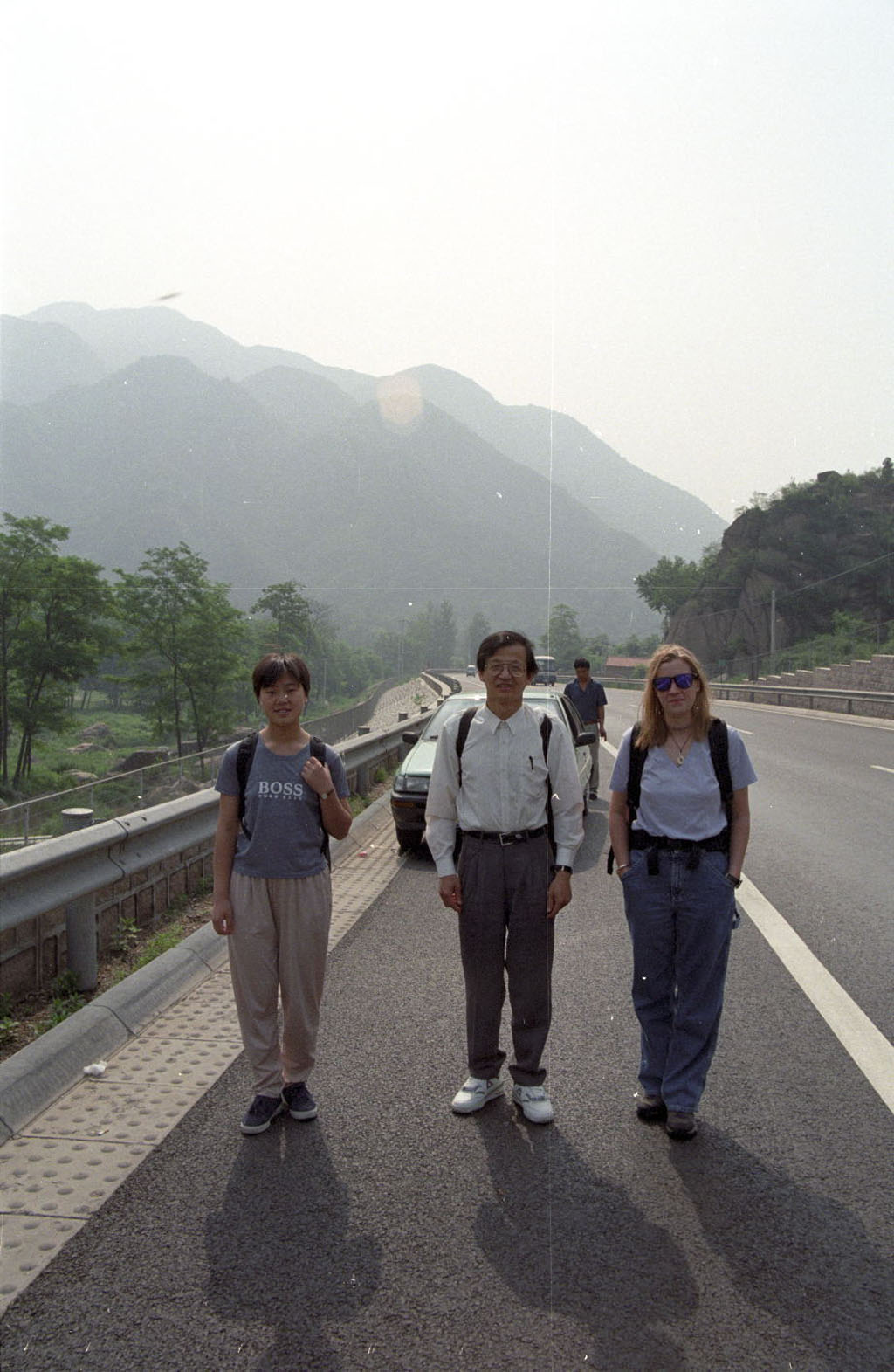
Three-quarters of our hardly little band as we started trekking to the Wall. We were ready! The driver and car can be seen in the background.

Unexpected things happen to those who get dumped onto breakdown lanes of big highways. The first thing we noticed while walking was that we were hardly the only ones with car trouble. In short order, we must have passed two or three other disabled vehicles. I decided I had to record at least one of them for posterity. When I turned around to photograph this van, with its rag underneath the engine, one of the passengers gave me a big, friendly wave and smile. Solidarity on the superhighway!

The next thing we noticed was that the nearby hills were full of decaying fragments of the Wall, or rather Walls, for the Great Wall is actually a collection of many smaller structures that generally overlap without being connected. In fact, our ultimate destination of Zhangjiakou is home to another section of the Wall, parallel to the section at Badaling. I had been looking forward to seeing both walls in the same day. You can see one of these smaller walls atop the nearby hill.
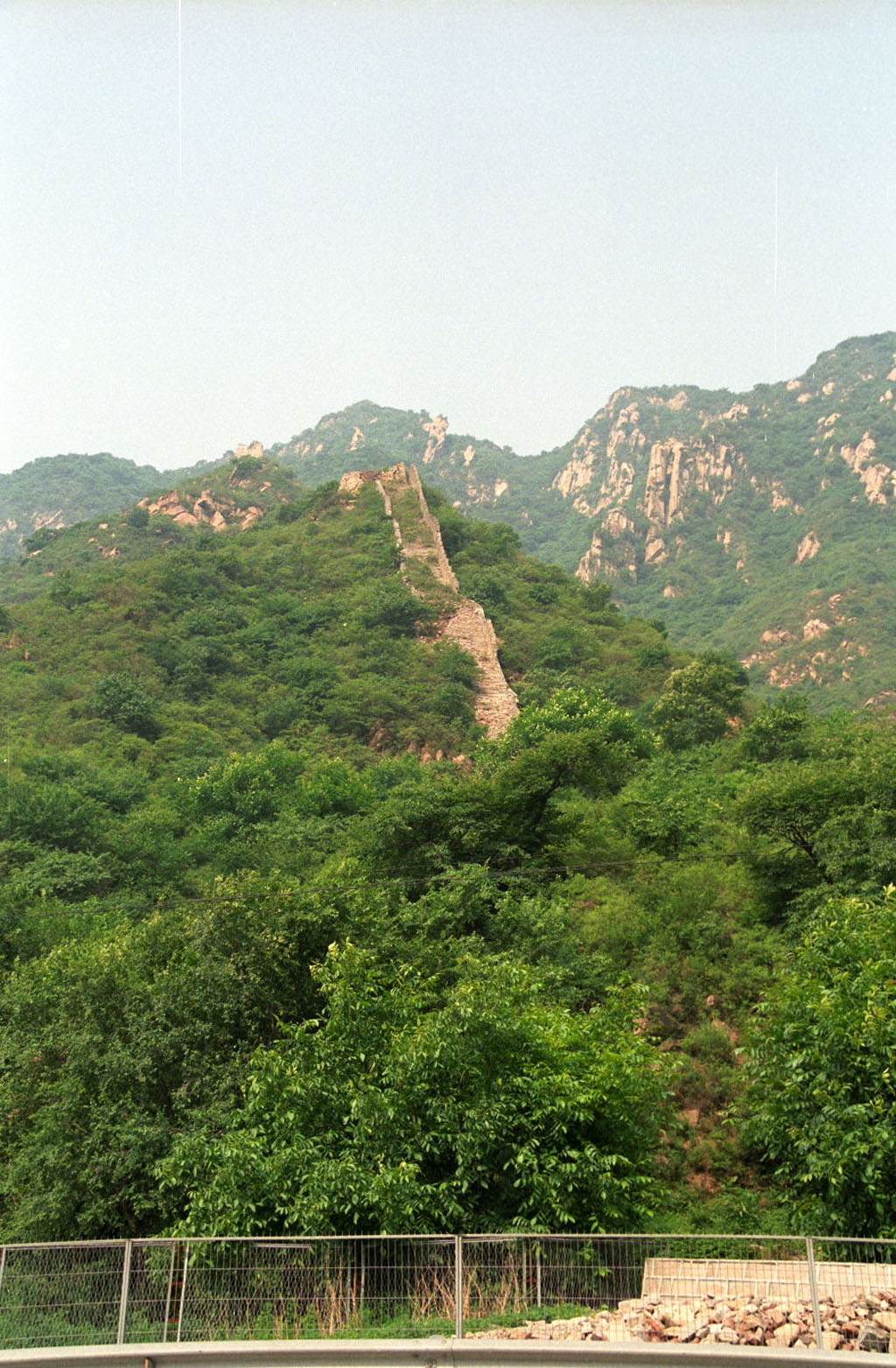
Here is the way this small section looked after we had walked a little farther.

We could see the wall's structure better after we had passed it. Walking to the Great Wall was turning out to be not so bad, after all. You would never notice these things while whizzing by in a car. You want walls; we give you walls!
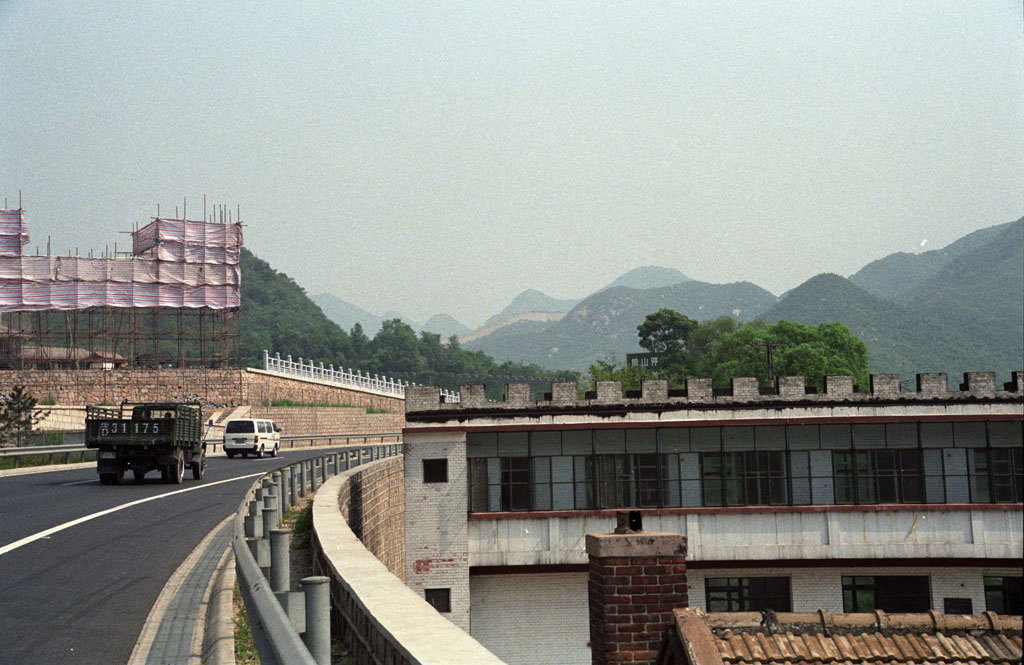
Of course, we really didn't want to be walking, mainly because we didn't know how far we were from the Wall. Optimistically, we had guessed only 12 km at the beginning. Those guesses quickly turned into 23 km or higher. As we rounded this turn, the real thing came into view, and it was considerably farther than that.
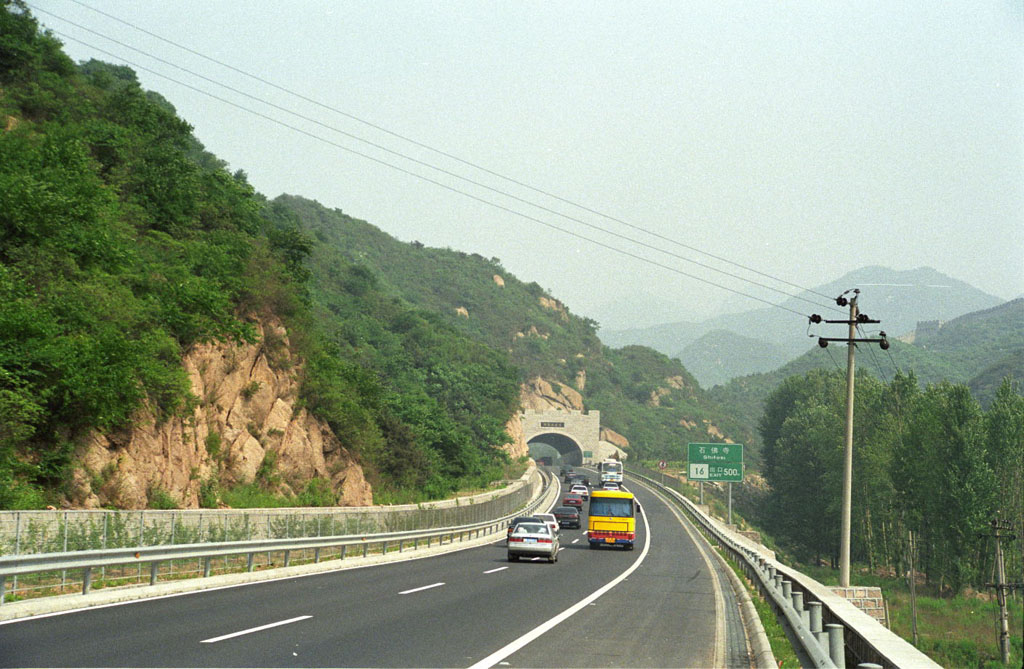
On and on we went. The scenery was beautiful, but the Wall
remained elusive. We walked through this tunnel, hoping to see the Wall in front
of us when we emerged. It remained too far away.
The sharp-eyed viewer may have noticed the lack of the other
direction of the highway. At the time, we didn't think much of it, mainly
because we were focusing on the Wall. Later in the day, we noticed from the
return bus that the other direction didn't exist! The Chinese had built the
expressway only one
way. I suppose everything is culturalin the
U.S., we build both directions for as far as we have the money, whereas the
Chinese had built one whole direction first.
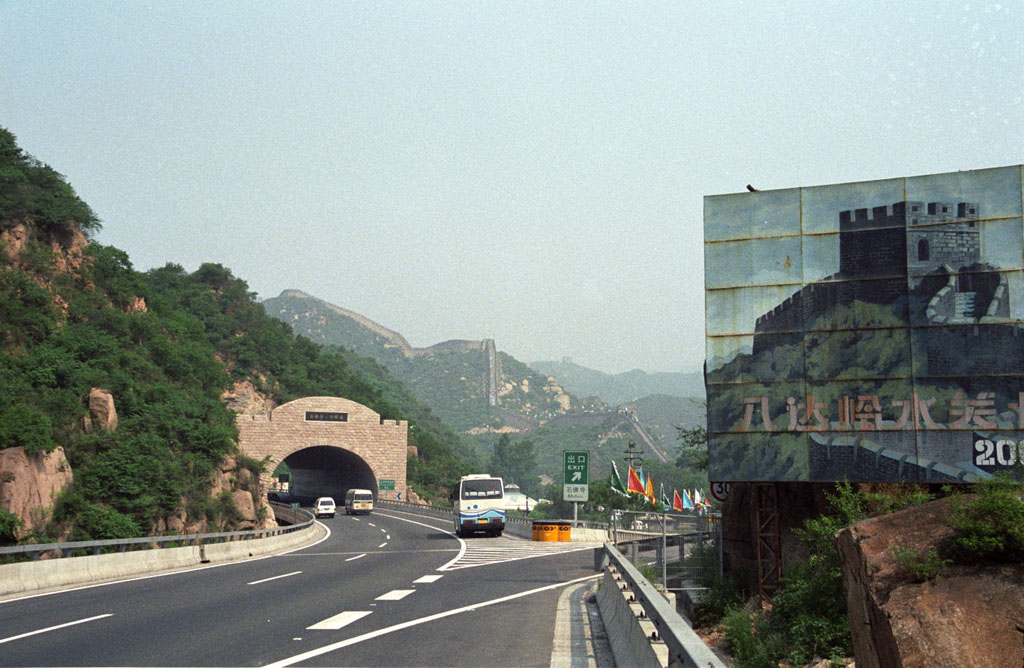
Eventually, we came to an exit with the Wall in view and a billboard on the right advertising the Badaling section. But the downtown area here looked too small to be Badaling. Jinghua ran to the bottom of the exit and asked a guard, who told her that Badaling was farther down the highway. So it was on past the broken-down bus and through the next tunnel for us.

Shortly after we passed through the second tunnel, an orange truck approached. The driver shouted something at us through a loudspeaker. Guoshun knocked on the window and said a couple sentences to him. The door then opened, and the driver smiled and beckoned us inside. Their conversation had been roughly: "Hey, you! Don't you know you're not allowed to walk along a superhighway?" "Come on! Do you really think we want to be walking here? Our car broke down back there, and we, with these two Americans, are trying to reach the Wall in the only way left to us!" The driver, who was the rough equivalent of the Highway Patrol, consented immediately to drive us to the Badaling exit. So we scrambled in and enjoyed the ride. You can see Jinghua in the front seat. You can also see the driver's microphone and amplifier for the outside speaker. The driver immediately reverted to form. As we were driving along, he would shout at all cars stopped for repairs. This time, we were on the good side of the microphone!
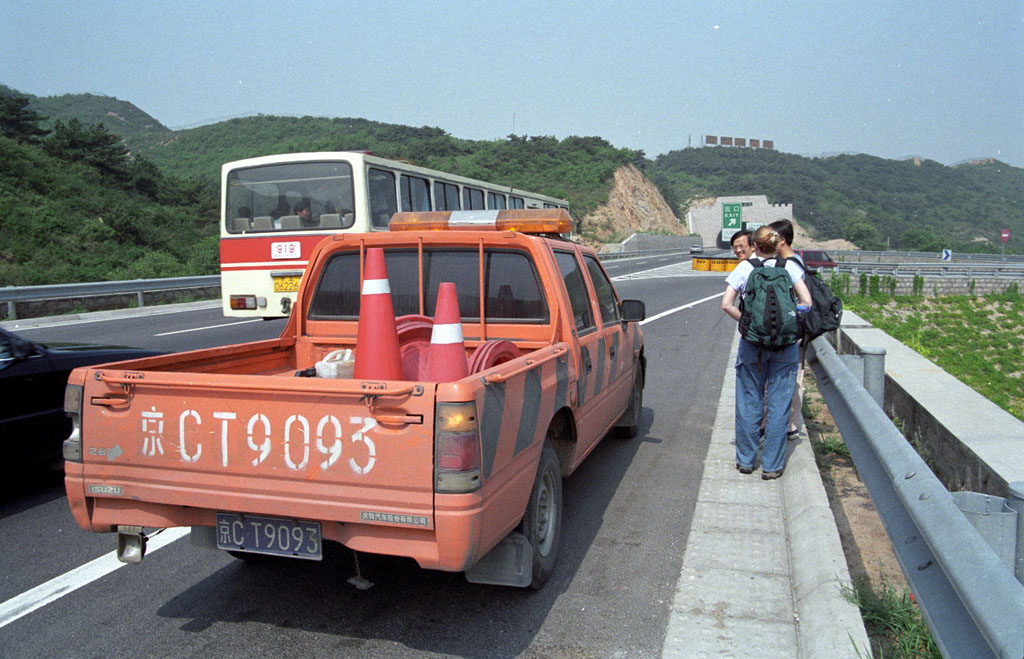
In a few minutes, we were there. We climbed out, thanked the driver profusely, and walked down the small exit ramp into Badaling and the real Great Wall. Our sprits had climbed in direct proportion to the extent that our tired feet had been rested.
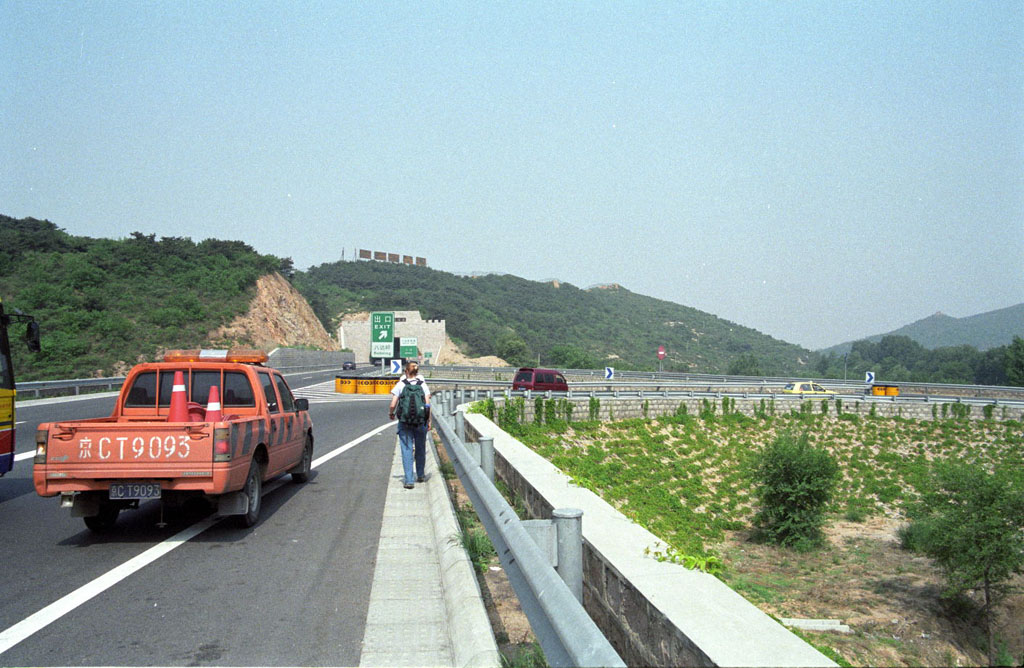
You can't see the Wall because it is behind us. Note all the other cars taking the exit to Badaling. It's a very popular place.